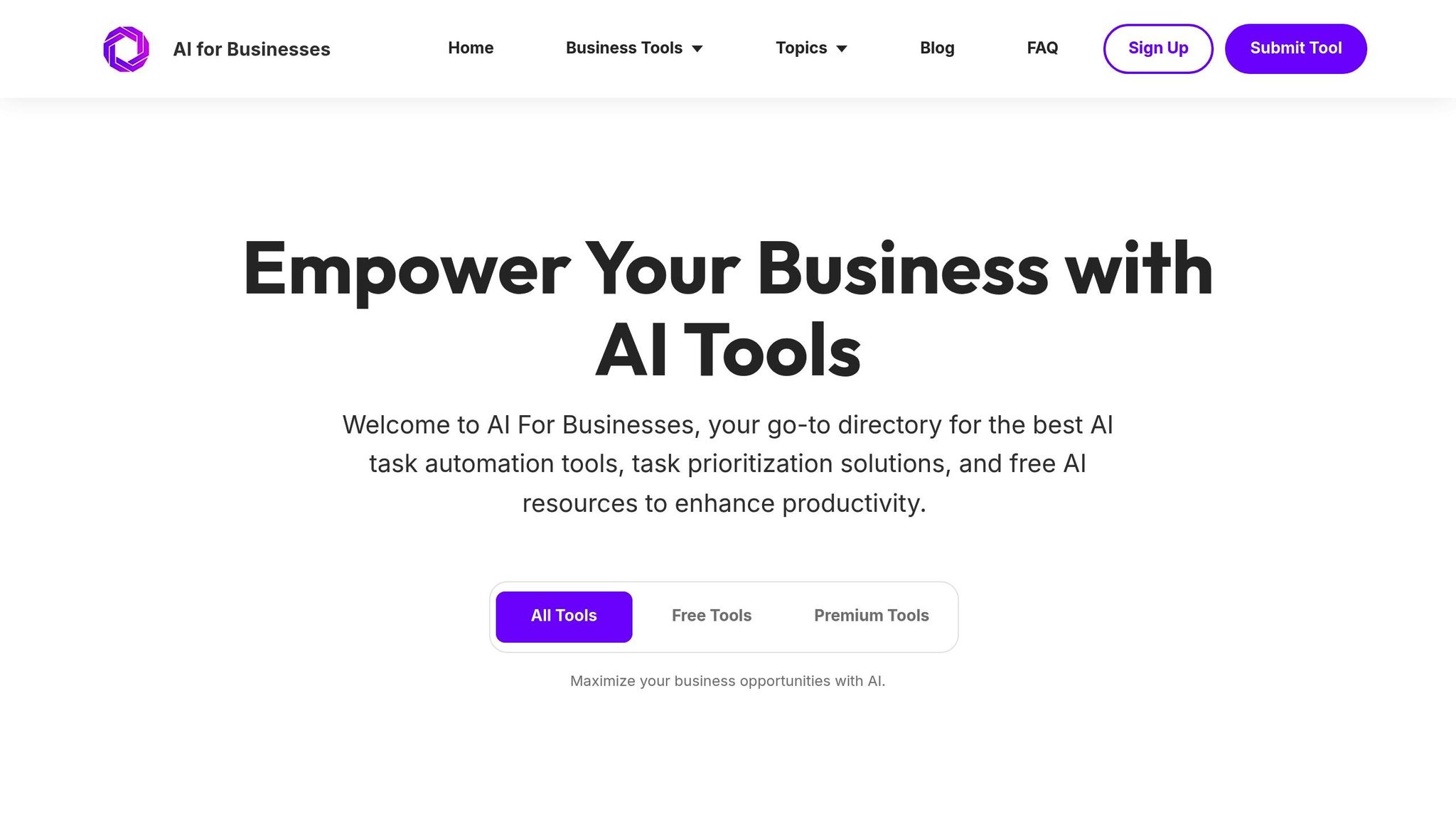In today’s fast-paced business world, outdated skill frameworks are holding companies back. Static systems based on annual reviews and rigid job descriptions fail to keep up with evolving market demands. This is especially challenging for small and medium-sized enterprises (SMEs) with limited HR resources. Enter AI-powered skill frameworks - tools designed to provide real-time insights, predict future skill needs, and help businesses stay competitive by aligning workforce capabilities with market shifts.
Here’s what AI-driven skill frameworks offer:
- Real-Time Updates: Continuously analyze employee activities, market trends, and role requirements to stay current.
- Skill Identification: Automatically detect skills through data from tools like project management software and learning platforms.
- Predictive Insights: Forecast future skill gaps and recommend targeted training or hiring strategies.
- Cost Efficiency: Optimize training investments by focusing on specific skill needs rather than generic programs.
- Improved Workforce Flexibility: Identify transferable skills within teams to fill roles internally and adapt quickly to change.
For SMEs, adopting these systems doesn’t require massive budgets or resources. Starting small with pilot programs and scaling gradually can make the transition manageable. Platforms like AI for Businesses provide scalable solutions tailored to different business sizes, offering tools that integrate seamlessly with existing systems.
The takeaway? AI-driven skill frameworks are reshaping workforce planning, making it easier for businesses to align skills with goals and adapt to market changes. Staying ahead in today’s environment means leveraging tools that provide actionable, data-driven insights.
Build AI-Ready Talent with AI Skill Pathways
The Problem with Fixed Skill Frameworks
Traditional skill frameworks, built around static job descriptions and annual reviews, just can't keep up with the speed of modern work. The numbers paint a clear picture: 59% of organizations admit their skills data is outdated or insufficient. On top of that, 71% of employees are already handling tasks outside their official job descriptions, and only 24% say their work matches that of others at their same title and level. These gaps between rigid frameworks and real-world demands lead to daily operational challenges and broader business risks.
Daily Operations Problems
Fixed skill frameworks create a ripple effect of inefficiencies in day-to-day operations, from hiring to project assignments. Many companies still rely on static tools like Excel, which results in outdated job descriptions and poorly aligned skill data. The manual data entry these systems require not only wastes valuable time but also leaves skill matrices outdated almost as soon as they're created.
For small and medium-sized enterprises (SMEs) with limited HR resources, the problem is even more pronounced. Their skill databases often fall far behind actual employee capabilities, leaving them without a clear picture of their workforce's strengths.
Another major issue is the lack of integration. When skill frameworks operate in isolation - separate from project management tools, performance tracking systems, or learning platforms - they fail to provide a full understanding of team expertise. Managers are then left making decisions based on incomplete or inaccurate information.
Adding to the confusion, inconsistent skill matrices across departments create communication barriers. Different teams may use varying terminology for the same skills, making it harder to identify and mobilize talent efficiently. This often leads to delays in project execution when the right skills aren't identified quickly enough, turning operational inefficiencies into larger business risks.
Business Impact Issues
The operational flaws of rigid frameworks don't just stay at the day-to-day level - they snowball into significant business challenges. One major issue is how these frameworks restrict talent mobility. By locking employees into outdated competency categories, companies miss the chance to tap into existing talent for new opportunities. This is particularly alarming given that over 50% of employees will need reskilling by 2025 due to technological advancements. Without a dynamic system, organizations struggle to identify who has transferable skills or the potential to grow into new roles.
The looming talent shortage only adds to the pressure. Seventy-three percent of business leaders expect to face ongoing talent gaps over the next three years. Yet traditional frameworks make it nearly impossible to pinpoint internal candidates who could fill these gaps with minimal additional training.
Then there's the financial fallout. Companies often waste money on learning and development programs rooted in outdated skill assessments. This leads to generic, compliance-focused training that doesn't align with employees' actual roles or career aspirations. The result? Employees disengage, and organizations see little return on their investment in training.
Perhaps the most damaging consequence is the loss of agility and innovation. Eighty-one percent of business executives report that work increasingly crosses functional boundaries, yet rigid frameworks make it difficult to build cross-functional teams. When market shifts or new opportunities arise, companies tied to traditional frameworks can't pivot fast enough. This lack of adaptability is a serious disadvantage, especially when 85% of executives believe businesses need more flexible ways to organize work to stay competitive.
The numbers highlight just how widespread the problem is: only 10% of HR leaders say they’ve successfully classified and organized skills into a comprehensive framework. That leaves 90% of organizations operating without a clear understanding of their workforce’s true capabilities. It's clear that static frameworks are no longer enough to meet the demands of a rapidly changing business landscape.
Dynamic Skill Frameworks Powered by AI
AI-powered skill frameworks mark a major leap from outdated, static systems to more responsive solutions that grow alongside your workforce. Traditional frameworks often rely on manual updates and yearly reviews, which can’t keep up with the pace of change. In contrast, AI-driven systems continuously adapt by learning from employee activities, project results, and market shifts, offering a real-time view of organizational capabilities.
The key difference lies in how AI processes multiple data streams at once. Instead of relying on self-reported skills or manager evaluations - both of which can quickly become outdated - AI analyzes real-world work patterns, project contributions, collaboration habits, and learning activities. This approach shines a light on skills that might otherwise go unnoticed, especially when employees take on tasks outside their formal job descriptions. Let’s break down how these frameworks operate.
Core AI Features
Modern AI skill frameworks leverage several integrated features to provide a detailed and ever-evolving understanding of workforce capabilities:
- Skill Detection Algorithms: These algorithms scan data from tools like project management software, communication platforms, code repositories, and learning systems. By identifying both explicitly stated and implied skills, they eliminate the need for manual data entry, ensuring the framework stays up-to-date.
- Natural Language Processing (NLP): NLP helps standardize skill terminology across teams. It unifies varied expressions into consistent categories, breaking down communication barriers caused by inconsistent skill definitions.
- System Integration: By connecting skill data with existing business tools, AI frameworks create a unified view of workforce capabilities. For example, syncing with project management tools can reveal which skills lead to successful project outcomes, while integration with learning platforms highlights development trends and suggests targeted training based on actual gaps, not generic assessments.
- Predictive Analytics: These tools convert historical skill data into actionable insights. They pinpoint which skill combinations drive success, predict future competency needs, and flag potential gaps before they become critical. This forward-looking approach is especially important given the growing challenges around talent shortages.
Role Evolution Forecasting
AI-driven frameworks don’t just analyze current skills - they also anticipate future needs. By examining industry trends, job market shifts, and internal project data, these systems provide early warnings about emerging skill requirements. This allows organizations to proactively address workforce planning challenges instead of scrambling to react.
- Internal Pattern Recognition: AI identifies how top performers combine skills to achieve success. For instance, if customer success managers with data analysis skills consistently excel, the system might recommend data literacy training as a strategic priority.
- Career Pathway Modeling: Instead of relying on outdated career ladders, AI maps realistic growth paths based on an employee’s current skills and market demands. These pathways highlight the competencies needed for advancement, offering employees clear and actionable steps.
- Gap Prediction: By analyzing project pipelines, employee development trends, and market data, AI flags areas where expertise might soon be lacking. This allows companies to plan ahead, whether by hiring new talent or offering targeted training.
Benefits for SMEs
For small and medium-sized enterprises (SMEs), AI-driven skill frameworks provide dynamic workforce insights without the need for large HR analytics teams. These systems address common talent management challenges while offering several key advantages:
- Efficiency and Cost Savings: By automating skill tracking and analysis, SMEs can save time and resources. Better internal talent utilization and more focused hiring efforts also reduce costs.
- Improved Internal Mobility: AI makes it easier to identify employees with transferable skills, enabling SMEs to fill roles internally and compete more effectively for external talent by focusing on essential competencies.
- Better Training ROI: Instead of generic training programs, these frameworks recommend skill development initiatives tailored to specific performance gaps and career goals. This ensures training investments directly contribute to business outcomes.
- Competitive Agility: With a clear understanding of current capabilities and emerging needs, SMEs can adapt quickly to market changes. In today’s fast-moving environment, having a flexible workforce is essential, and AI-powered frameworks provide the insights needed to seize new opportunities or tackle unexpected challenges.
sbb-itb-bec6a7e
How to Implement AI-Driven Skill Frameworks
Transitioning from traditional methods of tracking skills to AI-powered frameworks takes thoughtful planning and a clear strategy. The foundation needs to be strong, but also adaptable enough to grow as your organization evolves. Many small and medium-sized enterprises (SMEs) find success by starting with data integration and gradually building their AI capabilities as they see results.
Setting Up Your Data Foundation
The effectiveness of an AI-driven skill framework depends heavily on the quality and organization of the data it uses. Start by identifying and connecting key systems like HRIS (Human Resource Information Systems), LMS (Learning Management Systems), ATS (Applicant Tracking Systems), project management tools, and communication platforms. This creates a centralized hub for skill data and aligns your internal insights with external benchmarks.
Ensure your HRIS can export data in formats compatible with AI tools, such as CSV or JSON files. If it can’t, you may need to upgrade or invest in integration tools to bridge the gap.
Don’t overlook the value of project management platforms like Asana, Monday.com, or Jira. These tools often contain hidden indicators of employee skills. For instance, task assignments, completion rates, and collaboration patterns can reveal practical skills that formal assessments might miss. For example, an employee who routinely handles complex technical tasks demonstrates expertise that may not be reflected in their job title or description.
External data sources further enrich your framework. Industry reports, job market trends, and salary surveys provide context for validating your internal priorities. Many AI platforms can automatically incorporate this kind of data, helping you align your framework with industry norms.
Once your data foundation is in place, start with a small pilot program to test and refine your AI capabilities.
Start Small and Scale Up
Launching an AI framework doesn’t mean overhauling everything at once. Begin with a pilot program focused on high-impact roles. This approach minimizes complexity and allows you to gather insights before scaling up. Target positions where skill gaps have the greatest impact on business outcomes or where you already have strong data.
Customer-facing roles, such as sales representatives or customer success managers, are great options for pilots. Their activities often generate measurable outcomes, like conversion rates or customer satisfaction scores, which can help you evaluate the AI’s effectiveness.
Technical roles, like software developers, are another strong starting point. These positions leave clear digital trails - through code repositories, bug tracking systems, or project contributions - that AI can analyze to identify and categorize skills.
Start with basic functionality. Use AI to detect and categorize existing skills based on job descriptions, training records, and project assignments. This step helps you understand your current capabilities while testing the system’s accuracy.
Once you’re confident in the basic setup, gradually introduce predictive features. Begin with simple trend analysis, such as identifying which skills are gaining importance within your organization. Over time, you can expand to more advanced forecasting, like predicting future skill needs based on your business goals and market trends.
Validation is essential throughout this process. Compare AI-generated insights with observations from managers and self-assessments from employees. This not only helps fine-tune the system but also builds trust in its accuracy. Document any discrepancies and use them to improve both your data and the AI model.
After your pilot delivers consistent results, expand to other roles. Keep in mind that different positions may require unique adjustments to your AI models, as skill patterns and data sources vary across roles.
Building Continuous Feedback Loops
As your AI framework grows, it’s critical to establish feedback loops for ongoing improvement. AI systems need regular updates to stay accurate and relevant. Without this, they risk becoming outdated quickly.
Incorporate feedback from both employees and managers. Create simple ways for employees to verify or correct AI-generated skill assessments. For instance, you might introduce quarterly reviews where employees can flag inaccuracies or suggest missing skills. Keep these processes straightforward to encourage participation without adding unnecessary administrative work.
Validate AI insights by correlating them with performance outcomes. For example, check if employees identified as highly skilled in certain areas consistently deliver better results. If the correlation isn’t strong, investigate whether your data sources need adjustments or if the AI model requires retraining.
Regular updates to your AI models are essential. Schedule reviews - monthly or quarterly - of key metrics like prediction accuracy and user satisfaction. Use these reviews to identify areas for improvement or recalibration.
External benchmarking is another important step. Compare your AI-generated skill profiles with broader job market data and industry reports. If you notice gaps, adjust your models to better reflect current trends.
Finally, monitor your data quality to prevent performance issues. Set up automated alerts for unusual patterns, such as a sudden drop in completed training sessions or project updates. Addressing these issues promptly helps maintain the reliability of your AI system.
Choosing the Right AI Tools for Skill Frameworks
After diving into how AI is reshaping roles, it's time to focus on picking the right tools to build effective skill frameworks. The right AI tool doesn’t just streamline workforce planning - it can transform it. With so many options out there, your decision will depend on factors like your organization's size, technical setup, and specific needs related to skill management.
Key Features to Look For
When evaluating AI tools, these features should be top of mind:
- Skill detection accuracy: A good tool should identify skills from various data sources, such as project contributions, communication patterns, and performance metrics. Look for tools that clearly differentiate skill levels and proficiency.
- Integration flexibility: Ensure the tool integrates easily with your existing systems, like HRIS, LMS, or project management software, using reliable APIs. Seamless integration minimizes disruptions and maximizes efficiency.
- Taxonomy customization: Your tool should let you tailor skill categories to reflect the unique roles and requirements of your industry. This is especially important for specialized or emerging fields.
- Real-time updates: Static skill assessments can quickly become outdated. Tools that continuously track and update skill profiles provide ongoing value, especially in industries where skill demands evolve rapidly.
- Predictive capabilities: Beyond tracking current skills, the tool should help forecast future skill needs by analyzing trends and performance data. This feature is essential for staying ahead in competitive industries.
- User-friendly interfaces: Tools with intuitive dashboards, clear visualizations, and simple reporting features encourage adoption. If employees and managers find the system clunky, it won't get used.
AI Tools Comparison Table
Here’s a snapshot of how different categories of AI tools stack up:
| Tool Category | AI Skill Detection | Validation Support | Integration Options | Cost Range (Monthly) |
|---|---|---|---|---|
| Enterprise Platforms | Advanced multi-source analysis | Manager review workflows | Full HRIS/LMS integration | $15-50 per user |
| Mid-Market Solutions | Resume and profile scanning | Self-assessment validation | API and CSV imports | $5-25 per user |
| Specialized Tools | Industry-specific detection | Peer review systems | Limited integrations | $10-30 per user |
| Basic Platforms | Keyword-based matching | Manual verification only | Basic data imports | $2-10 per user |
The pricing differences usually reflect the complexity of the AI algorithms and how well the tools integrate with existing systems. For instance, enterprise platforms often offer the most robust features but may be more than a smaller business needs. Mid-market solutions often strike the best balance between functionality and affordability for small to medium-sized enterprises (SMEs).
Spotlight: AI for Businesses

For SMEs exploring AI-powered skill management, AI for Businesses provides a curated directory of tools tailored to their needs. This platform highlights AI solutions like Writesonic for assessing content creation skills and Looka for evaluating design capabilities, among others designed to improve business processes.
The directory operates on a tiered pricing model:
- Basic plan (free): Access a limited selection of AI tools to test and experiment before committing.
- Pro plan ($29/month): Unlimited access to all tools, plus priority support - ideal for growing businesses needing comprehensive solutions.
- Enterprise plan (custom pricing): Tailored solutions and dedicated support for larger organizations with more complex needs.
What makes AI for Businesses stand out is its focus on tools that directly improve business operations, such as workforce planning and skill development. This curated approach saves time during the evaluation process and minimizes the risk of investing in tools that don’t deliver meaningful results.
The platform also aligns well with a gradual adoption strategy. Start with the free Basic plan to explore your options, move to Pro as your requirements grow, and eventually transition to Enterprise-level solutions as your team becomes more comfortable with AI. This step-by-step approach helps organizations avoid overcommitting to tools they’re not yet ready to fully utilize.
Conclusion: Transforming Workforce Planning with AI
Shifting from rigid, traditional methods to dynamic, AI-driven systems is reshaping how small and medium-sized enterprises (SMEs) approach workforce planning. The days of relying on annual reviews and static job descriptions are quickly becoming a thing of the past, as these methods struggle to keep up with the fast-changing business environment.
AI-powered frameworks offer several key advantages over outdated systems. They can identify skill gaps automatically, cutting down on the guesswork. By optimizing training efforts and tapping into existing internal talent, these systems also help reduce costs. Perhaps most importantly, they enhance workforce flexibility, enabling businesses to adapt swiftly to market changes.
Some companies still rely on old-fashioned talent inventories, missing out on the untapped potential within their teams. AI-driven tools, however, uncover these hidden strengths, opening up new possibilities for growth and efficiency.
To address the challenges of skill management, platforms like AI for Businesses provide scalable solutions. These range from free, basic tools to more advanced options, making it possible for SMEs to access cutting-edge workforce planning without needing enterprise-sized budgets. This levels the playing field and removes traditional barriers for smaller companies.
FAQs
How can small businesses implement AI-powered skill frameworks on a budget?
Small businesses don’t need to break the bank to integrate AI-powered skill frameworks into their operations. Thanks to affordable tools and services, getting started is more accessible than ever. Open-source platforms like TensorFlow and PyTorch provide powerful AI capabilities without the hefty price tag. Similarly, cloud-based AI services offer advanced functionality while cutting out the need for costly infrastructure.
For those seeking more tailored solutions, there are plenty of AI tools designed specifically for small businesses. These tools can help automate repetitive tasks and address specific skill gaps. By starting with smaller, focused projects that tackle key operational needs, businesses can gradually introduce AI into their workflows. This step-by-step approach makes it easier to scale over time while keeping costs manageable.
What are the benefits of using AI-driven skill frameworks instead of traditional static ones?
AI-driven skill frameworks bring a fresh approach to managing workforce skills, standing apart from traditional systems that often rely on outdated, rigid skill sets. These advanced solutions adjust in real-time to reflect changes in job roles and industry trends, helping organizations stay ahead in an ever-evolving market.
By automating updates and cutting down on manual work, AI frameworks streamline HR processes, making skill matching more accurate and workforce planning more effective. This adaptability empowers businesses to quickly respond to shifting demands while refining their talent management strategies.
How can AI-driven skill frameworks help predict future workforce needs and improve planning?
AI-powered skill frameworks leverage cutting-edge algorithms to sift through massive datasets, pinpoint emerging trends, and track how skill demands are shifting in real time. By automating the process of identifying skills and keeping role-based frameworks up to date, these systems offer businesses a flexible and forward-thinking way to plan their workforce.
With these frameworks, companies can model different scenarios, allocate resources more strategically, and tackle skill gaps before they become critical. This approach helps businesses stay flexible, keep up with technological advancements, and be ready for the evolving demands of the workplace.


